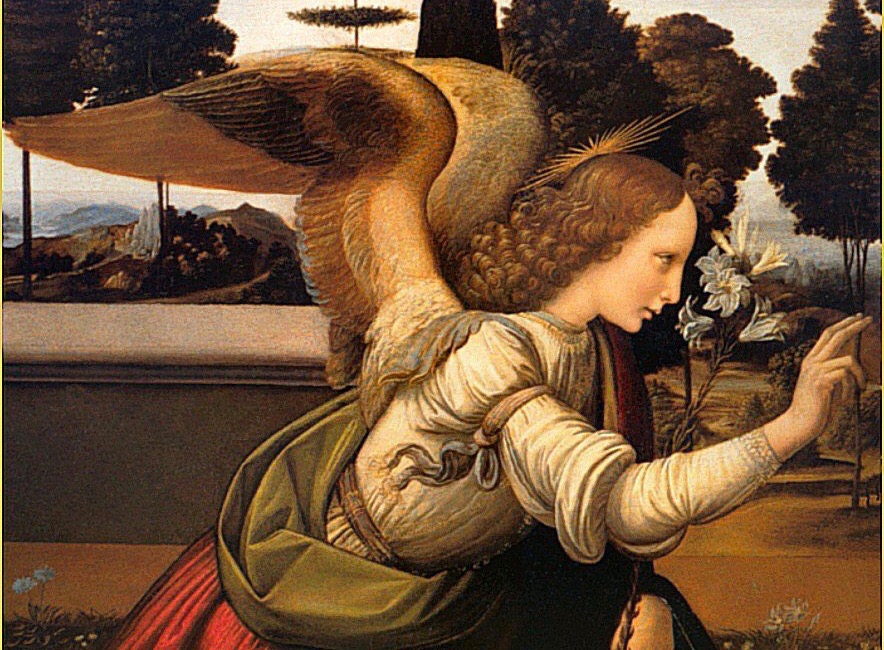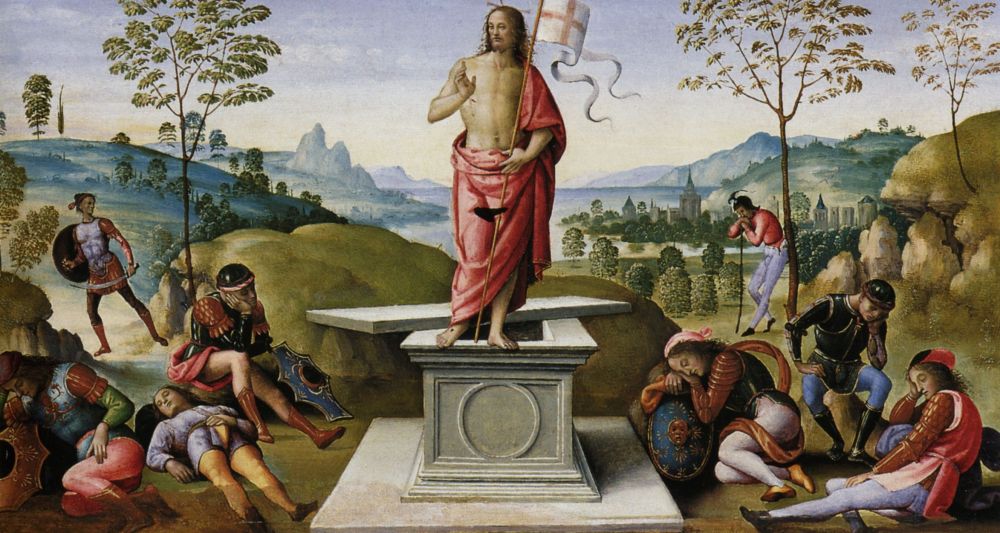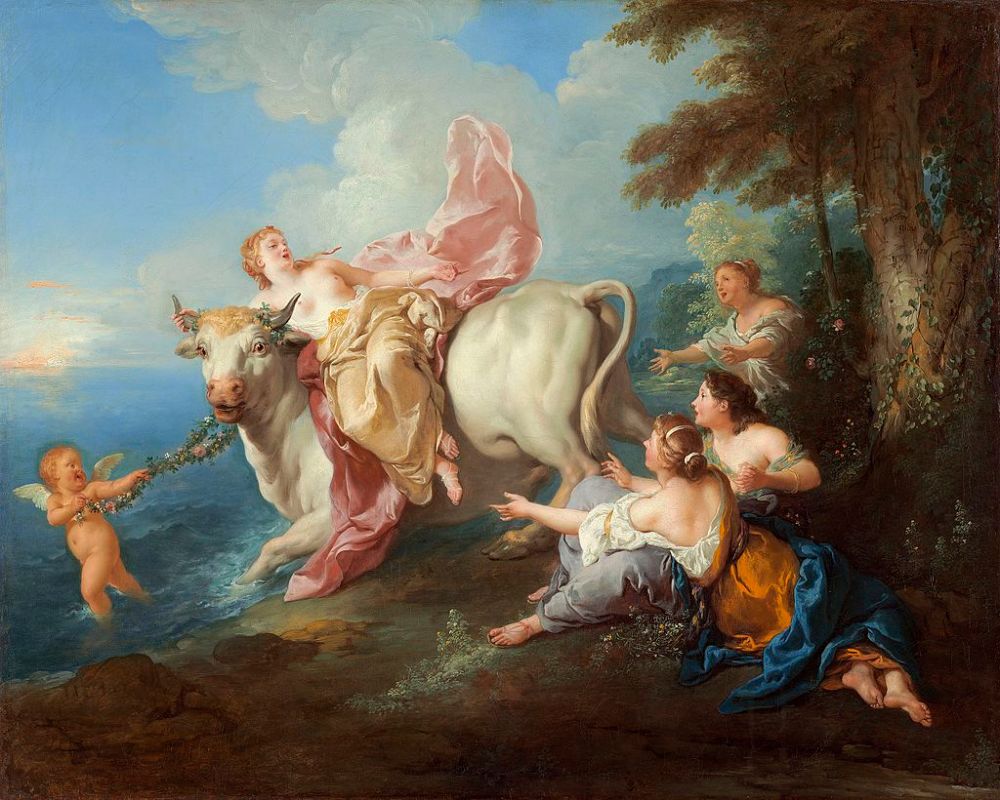Note to reader: A closer examination of the New Testament has forced me to reconsider a previous assumption that is commonly accepted, namely that the divine father of Christ is Yahweh. While it is clear that Christ is a Jewish figure essentially synonymous with Yahweh, it is likely his father is Aryan. Little of my work is concerned with the identity of Christ’s father, so little revision will be required, nevertheless this an important discovery for reasons indicated in these articles. Revisions of my work, appearing here or in book form, will assume the likelihood that Christ’s father is indicated as Aryan.
“The Annunciation to The Blessed Virgin Mother Mary,” appearing in the Gospels, describes an Angel visiting Mary in Nazareth to apprise her of her impending conception and pregnancy. As this study discusses, visitation from a male figure, who successfully prophecies a pregnancy, is a trope we see repeated in the Biblical works.
For example, Mary’s Levite descended relative Elisabeth, The Wife of Manoah (Samson’s mother), “the Shunamite woman” in the second Book of Kings (possibly Jonah’s mother), Abraham’s wife Sarah (Isaac’s mother), all receive visits from Prophets, Angels or Yahweh himself. In each case, the divine visitor correctly prophecies that they will soon bear children.
In this study, I argue that each of these “predictions” indicates sexual unions. Here a male figure says what will occur. It is implied as well that he makes “it” happen, that this visitation is causal. After all, how might he predict such a thing? This is especially clear in Genesis 18, this study argues, where it is esoterically suggested that Abraham has offered his wife to a visiting Yahweh. In fact, it may be argued that later occurrences of this motif become more subtle references to Genesis 18, for example, which goes some way in establishing the trope.
In Mary’s annunciation in Matthew, the visiting Angel is unidentified. This study asserts that Angels, in general, as figures, are Aryan with a few exceptions. Regardless, the term or concept of Angel itself is best understood as an Aryan identifier. Again, here we understand Angels as ephemeral servants of Yahweh, while Yahweh himself a synonym of Judah or the Jewish people collectively. Thus they are distinct from the important, continuing portion of Jewry. In Luke the Angel is identified as Gabriel.
There are reasons to believe that Gabriel in particular is an Aryan figure. Alongside Michael, a clear Aryan figure as this study describes, Gabriel is given the janissary function of guardian of Israel. In fact, he is understood as working alongside Michael in God’s court.[1] The Jewish encyclopedia indicates him as assuming the form of a man and this may be meaningful. Here perhaps he is understood as something akin to the Aryan Adam or a “face” and front-man of the God, as opposed to the often incorporeal, elemental or invisible Yahweh himself.[2]

Other clues may as well suggest Gabriel as a particularly Aryan figure. In Jewish mysticism, Gabriel is associated with the sefirah Yesod, יסוד, which means “foundation,” “fundamental,” “laying the foundation,” “establishment,” “setting up,” and “formation.” It’s the ninth sefirah and is associated with the moon. With the Kabbalah tree we are given the sense of a Semitic serpent or vine entwining and traveling up the Aryan tree of life, finally to its crown. Yesod, ostensibly, represents that first stage “off the ground” or off Malkuth.
The reason Yesod is associated with the moon is opaque but may suggest a reference to the primordial lunar God Sin or Nanna, a Semitic God who is the product of an Aryan and Semitic admixture as this study explicates. Hence arguably at the base of the Aryan tree, one “lays the foundation” or forms “the beachhead” for a “genetic infiltration.” Regardless, as this study discusses, the number nine, perhaps most strongly associated with pregnancy, the menstrual and thus also the lunar cycles, might be guessed as an Aryan identifier. After all, the Aryan clearly represents the “womb” from an esoteric Jewish Bride Gathering perspective.
Gabriel’s name means “God is my strength,” “God is my strong man” or “God is my hero.” If nothing else, this seems to convey a distinctiveness from the Jewish God whose name appears in the Angel’s name as “El.” Here it is important to note, while Gabriel is an Aryan figure, as this study argues, he is nevertheless a servant of “El” or the Jewish God, much as “Pantera” is potentially a servant of Bacchus. Hence the conceiving of Christ, and the admixing of a male Aryan figure and a female Jewish figure, occurs by a Jewish direction. But this of course is obvious to us as the New Testament itself, developed to inform and guide thought and behavior, is given to us by Jews.
There are more things that suggest that Mary will give birth to a Jew by an Aryan father. In Luke 1:35, Gabriel informs Mary that “The Holy Spirit will come on you, and the power of the Most High will overshadow you. So the holy one to be born will be called the Son of God. Even Elizabeth your relative is going to have a child in her old age, and she who was said to be unable to conceive is in her sixth[3] month.”
As this study discusses the “Holy Spirit,” whether Psyche or, in this case, “pneuma,” is Aryan, understood in myth as a reference to the beautiful Aryan Goddess Psyche or the animating breath of the Aryan Goddess Minerva. This is also the dove of Inanna or Venus that visits Christ during his Baptism. The Aryan Eve is also a synonym of this Holy Spirit. Here we may find it interesting to note that in Islam the angel of Gabriel and the concept of Holy Spirit are commonly treated as synonyms.

Rejoicing with Elizabeth at the news she will bear Christ, Mary will declare: “My soul magnifies the Lord, and my spirit rejoices in God my Savior.”[4] As we understood soul and spirit to signify the Aryan element, and Lord or “Kyrios” the Jewish element, as this study discusses, we understand this intermixture with an Aryan father to be celebrated in this passage by a Jewess. It is a celebration of a quickening of the blood, an Aryan Brain Drain, intermixture with an Angel, understood as especially wellborn, beautiful and intelligent beings or Aryans, greater than mere mortals. It also becomes the celebration of a “salvation,” or an “in” or connection to the ruling Aryan host.
In Jewish mythology, Gabriel is understood as delivering souls from the Tree of Life to the Semitic female being of Lailah to incubate before their birth as persons into the world. This may suggest a relationship similar to Gabriel’s and Mary’s.[5] The name Lailah, לַיְלָה, related etymologically and in meaning to the more famous name Lilith,[6] means “night.”
Here the notion appearing in Luke 1:35 that the power of the “Most High will overshadow” Mary when the “Holy Spirit” comes onto her is interesting. As indicated in this study, the title of “Most High,” which is the translation of the Hebrew Elyōn, is almost certainly a reference to the Jewish God. The Greek word here used for “overshadow” is episkiazó, ἐπισκιάζω.
Episkiazó, derived from the root skai, σκιά, meaning “shade” or “thick darkness,” appears one more time in Luke, once in Matthew, once in Mark and once in Acts. In the Gospels it describes Jesus or Yahweh appearing as a cloud, one of the important symbols of the God, to miraculously envelope, darken or “cast shade” upon Peter while he speaks.
In Acts it is used once to describe the magically healing shadow of Peter as he walks among the denizens of Jerusalem, presumably also here appearing as a symbol for the Jewish God. Blackness or swarthiness too, as this study explicates, is a Jewish identifier and likely this symbol of a darkening cloud is related.

During Mary’s annunciation, amazingly this described “overshadowing” may describe the “overshadowing” and even “shading” or “darkening” power of a dominant Jewish gene vis-à-vis a recessive Aryan “Spirit” or gene. This would conform with a clear understanding of the dominance of Semitic genes that reappears throughout the JEM. In Luke the angel will even reassure her, telling her:
“Do not be afraid, Mary; you have found favor with God [Theos]. You will conceive and give birth to a son, and you are to call him Jesus [“Yahweh is salvation”]. He will be great and will be called the Son of the Most High [Elyōn]. The Lord God [Kyrios ho Theos] will give him the throne of his father David, and he will reign over Jacob’s descendants forever; his kingdom will never end.” To be clear, the inseminating Aryan angel her is reassuring her that her son will be Jewish, one with the Jewish God Yahweh.
The above passage becomes decipherable when we understand that “Theos” is a reference to an Aryan God akin to Jupiter, “Jesus” is a reference to the Jewish God, “Elyōn” is a reference to the Jewish God, “Kyrios ho Theos” is also a reference to the Jewish God, “father David” a reference to Jewry and “Jacob and his descendants” a reference to Aryans or a broader humanity. How did I arrive at this conclusion? The terms, figures and meanings of Elyōn, David and Jacob are covered in the broader study. I demonstrate that they carry the definitions I’ve indicated. “Theos” and “Kyrios” are covered below.
Theos an Aryan identifier, Kyrios a Jewish identifier
Theos, the title given to “God,” the creator and father of Christ, in the New Testament, indicates an Aryan figure, I argue. The word Theos is Indo-European sharing the same root of Dyēus, the reconstructed chief God of the Indo-Europeans. It derives from *deiwos meaning “celestial” or “shining.” The name Zeus is closely related. Of far greater interest to us, though, is how Jews are using this term in the New Testament. Here we assume Jews to be using words precisely and correctly in their characteristic manner, particularly in such a critical context as the New Testament.

Theos, in the Greek, and Deus, in the Latin, appear in Jewish writings as somewhat generic terms for “God.” Indeed, in the Septuagint Jews will tellingly use the term Theos to translate the term Elohim which describes a plurality of Gods. This study argues that the use of Elohim, appearing in the Hebrew Bible, particularly in Genesis, describes a broader pantheon of earlier Gods whom are essentially Aryan.
It is from these Gods which the Jewish Yahweh is descended, much as Vulcan is descended from the Olympians. Hence the term Theos, when used by itself, should at least be understood as referencing Gods that may be Aryan and may not include Yahweh. Of course, as every symbol appearing in JEM, the term should be scrutinized in context.
The Scutum Fidei or “shield of trinity” diagram, appearing from the Church in the late medieval period, suggests all three entities of The Trinity, The Father, the Son and the Holy ghost are “Deus,” yet also distinct from one another. This would conform perfectly with our understanding. For instance, this may be indicating the Father is Aryan, the Son Jewish and, of course, the Holy Spirit as the feminine, sexually accessible Aryan element.
Christ on the other hand commonly goes by the tile Kyrios or kurios in the New Testament. Kyrios is a Greek word meaning “lord,” “master,” and “teacher.” In classical Greece it referred to the head of a household. It’s commonly guessed that the title, in the context of the New Testament, functions as a replacement for the Semitic title Adonai which carries the same meaning of “lord” as does “El,” as this study discusses. Of course, it is also commonly guessed that Theos was effectively a replacement for Yahweh or YHWH, a point which I assert is likely false. Nevertheless, Kyrios is likely a synonym for Adonai here, given the certainly that Christ is a Jew.

Readers will be curious to know if the words Kyrios or Kurios are related to the Kouros or Kouroi, the freestanding statues that represented the Apollonian youth. Etymologists do not point to this. They surmise keuə is the Proto-Indo-European root from which Kyrios descends, while Kouros descends from ker. It is true, though, that the proposed meanings of these two roots are perhaps similar. Keuə means “to swell,” but also “vault” and “hole.” Ker means “to grow” and is thought to be the root for the Latin word crescere meaning “come forth,” “spring up,” “grow,” “thrive,” and “swell.”
This is almost certainly irrelevant. Indeed, strong patterns in JEM suggest that the established meanings of the words would have been more strongly considered by the careful and intelligent Jewish writers of the New Testament just as they would be in the contemporary context. Indeed, arguably the words are almost opposite in meaning. Kouros means “youth” or “boy,” especially of noble rank, whereas Kyrios implies fatherhood, age and authority. Elsewhere in this study I argue the Apollonian cult, a Eugenics Cult, was interested in a racial rejuvenation.
The significance of an Aryan Father of Christ
Finally the question must be asked, if Christ’s father is indicated an Aryan being, why is this meaningful? For one it might explain an important psychological mechanism, alongside the “anti-Semitism” of Christianity, by which this cult was initially transmitted.

For example, literate non-Jewish adopters of Christianity, speaking Greek or familiar with the Greek, would have been familiar with terms like Theos and perceived them as relatively innocuous. Indeed both Luke and Acts are addressed to a likely hypothetical person named Theophilus meaning “fried of God.” It’s possible if not likely this person is posited here as the archetypal non-Jewish audience member who was presumed still loyal to the Greek Gods.
Indeed, to the extent Theos had an “ethnic ring,” this “Indo-European,” Greek word would be perceived as a word describing a Grecian God. From the contemporary perspective, whether or not a God is a “Greek God,” tells us little about their actual ethnic identity. Yet in the Ancient world this would have been meaningful.
After all, we’ll remember that Aryan Apollo was understood as the “Most Greek” God, while figures like Bacchus and Adonis understood as describing foreign or Eastern Gods. Hence audiences, to the extent they possessed a basic understanding of the dominant Greco-Roman Religion, would have guessed, correctly, I assert, that Christ was understood as having an Aryan father.
At the very least, Ancients familiar with Bacchus’ birth or Mercury’s birth by Jupiter would have seen or perceived similarities. Christianity, of course, borrows heavily from the Adonis cults as well. There, though, surviving myths indicate a mortal father. Hence to the extent a God as father is established as a trope in salient cults in the Greco-Roman world, it is a trope involving the Aryan Jupiter or Zeus as father. This would be of course also the case with a cult that already resembled the Bacchus Cult.
It is, of course, meaningful, nevertheless, that Jupiter or Zeus are not indicated as a father here by name. This suggests a desire to lead flocks away from these cults toward a vaguer, more “inclusive,” and universalist understanding of God. To the extent Theos was understood as an abstract, generic, theoretical or philosophical term for a “creating, governing God,” it would have also been relatively innocuous. But again, I assert Aryan ethnicity of Christ’s Father is implied here through this word and asserted even more clearly through other more specific symbols.

Indeed, it is without question though that Christianity was developed to be a “Mystery Religion” or opaque in meaning vis-à-vis non-Jewish audiences. Hence the sense that Christ’s father is Aryan is conveyed also by the more careful details of JEM, I argue, if also by these more obvious hints. Here we may reasonably guess that non-Jewish adopters of the faith had degrees of understanding based on their knowledge of the Greek myth Christianity heavily references. Hence I would argue the propaganda here is twofold, operating on the semi-conscious as well as the unconscious. In both instances the notion of an Aryan father and a Semitic or Jewish son is conveyed, whether to the conscious mind or the unconscious mind.
The psychological reasons for indicating or suggesting that Christ is the son of an Aryan father with a Jewish mother versus the son of a Jewish father and an Aryan woman, should be obvious. The Aryan male as a sexual competitor feels less threatened by this idea and reasonably. This is particularly true as we understand this divine “Theos” as essentially an abandoning father. In other words, Jupiter’s investment in parentage is still with the Aryan Mars, for example. This may also explain some of the irritation with Christianity arising from Jewish quarters, even if this irritation is largely subconscious in origin and even if the top minds of Judaism would have understood Christianity as developed consciously and beneficial to Jewish interests.
Of course Christianity itself, positing ultimately the cuckold, de facto Aryan Joseph as a model for the Aryan father, does not promote a Jovial or Jupiter-like type, whether as the deleterious philandering caricature he would become or otherwise. Likewise, the Jewish Christ becomes a Jewish fertility God as discussed in this study. As well, the admixed Jewish Christ becomes the “ideal son” and hence a powerful propaganda for intermixture and racial permissiveness if operating largely on the subconscious level. This would serve the Jewish instinct and religious prerogative of marrying into powerful “Benjamite” or Aryan clans where daughters are eagerly offered. The Christian, encountering a well-presenting Jewish suitor for his daughter, in the end remembers that Christ himself, “the best of us,” was also a Jew. Ultimately, of course, Christ becomes the opposite of Jupiter, the vengeful, scythe-wielding Saturn or “Son of Man” as revealed in Revelation 14:14.
If we assume Christ’s father a cuckolding Yahweh or Jew we find an easy argument in favor of discarding Christianity outright, hence we may be disappointed in this understanding that Jesus’ father was an Aryan. But we should not be disappointed as an understanding of this myth returns to us executive powers. Here Christ appears as Adonis, a seasonal, Dying-and-Rising God who is allowed visitation to the Aryan Venus or Mary Magdalene only by the generosity of Jupiter. Since Jupiter is us, as much as Yahweh, Christ and Adonis is them, we are given executive powers to end this destructive cycle, whereby our women are made the exploited womb of an alien who mocks and despises both them and us. Here “Deus Vult,” removed from its Christian historical context, becomes a much less stupid and offensive term. Though it is clearer in this day to say “Jupiter Wills it.” We are unsurprised to learn the end of Christianity is encoded in its beginning.

[1] Gabriel. Jewish Encyclopedia. 5. 1906. pp. 540–543. Retrieved December 2, 2016.
[2] Jewish Encyclopedia. 5. 1906. pp. 540–543. Retrieved December 2, 2016.
[3] The use of the number 6 maybe meaningful here. It is identified in this study as referencing the solar and Aryan as resource.
[4] Luke 1:46-47
[5] “200_ THE TREASURY OF SOULS for Tree of Souls: The Mythology of Judaism”. Scribd. Archived from the original on 2012-10-30. Retrieved 15 June 2015.
[6] Lilith means “night spirit,” or “owl.”
3 thoughts on “The Racial Identity of Christ’s Parents Part II: The Annunciation Proof”